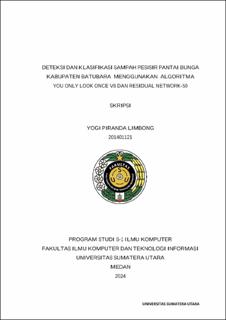Deteksi dan Klasifikasi Sampah Pesisir Pantai Bunga Kabupaten Batubara Menggunakan Algoritma You Only Look Once V8 dan Residual Network-50
Detection and Classification of Coastal Garbage on Bunga Beach Batubara District Using The You Only Look Once V8 Algorithm and Residual Network-50

Date
2024Author
Limbong, Yogi Piranda
Advisor(s)
Harumy, T Henny Febriana
Sharif, Amer
Metadata
Show full item recordAbstract
There are 3 categories of waste, namely organic waste which originates from living organisms and easily undergoes natural decomposition processes. Inorganic waste is waste that is difficult to degrade or undergoes a very long decomposition process, and hazardous and toxic waste (B3) which contains potentially dangerous chemicals and toxic substances. It has chemical compositions that can endanger human and environmental health, both directly and through long-term exposure. The impact of waste on the coast is not limited to just the economic and tourism sectors but also extends to the lives of organisms in marine ecosystems, environmental pollution or damage, as well as aquatic ecosystems, and can pose risks to human health. Therefore, a system is needed that can detect and classify such waste. In the process, images of waste are inputted into the system for detection using the YOLOv8 algorithm via bounding boxes, and the detected results are then classified using the ResNet-50 method to categorize the waste into 3 types: organic, inorganic, and hazardous and toxic waste (B3). Detectable waste includes leaf waste, wood waste, fruit waste, plastic, paper or tissue, styrofoam, and cigarette waste. The testing results of the YOLO model obtained an accuracy value of 0.87, precision of 0.90, recall of 0.89, and F1 Score of 0.89, and the testing results of the ResNet-50 model obtained an accuracy of 0.89, precision of 0.89, recall of 0.89, and F1 Score of 0.89, with the overall system testing results achieving 85% out of 20 attempts.
Collections
- Undergraduate Theses [1254]
